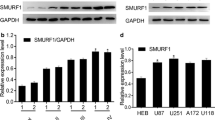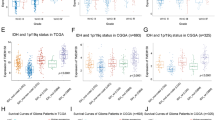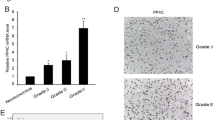Abstract
Glioma is an extremely aggressive and lethal form of brain cancer. Despite recent advances in diagnostics and treatments, prognosis for advanced patients suffering from these diseases remains poor. Therefore, identification of new therapeutic targets for glioma is of significant importance. In this study, we identified the important role of Smad interacting protein 1 (SIP1; also known as ZEB2) in glioma. We firstly found that SIP1 expression was high in four tumorigenic glioma cell lines but low in two nontumorigenic glioma cell lines. By knockdown or overexpression assay, we discovered that knockdown of SIP1 expression statistically significantly inhibited cell migration and invasion of tumorigenic glioma cells, while overexpression of SIP1 promoted cell migration and invasion of nontumorigenic glioma cells. SIP1 knockdown inhibits and overexpression promotes glioma cell clonogenicity in vitro. Further studies identified that SIP1 overexpression inhibits expression of E-cadherin and enhances expression of mesenchymal proteins such as fibronectin and vimentin. This study supports the rationale for developing SIP1 as a potential therapeutic and diagnostic target for gliomas.






Similar content being viewed by others
References
Louis DN, Ohgaki H, Wiestler OD, Cavenee WK, Burger PC, Jouvet A, Scheithauer BW, Kleihues P (2007) The 2007 WHO classification of tumours of the central nervous system. Acta Neuropathol 114:97–109. doi:10.1007/s00401-007-0243-4
Sathornsumetee S, Rich JN (2006) New treatment strategies for malignant gliomas. Expert Rev Anticancer Ther 6:1087–1104. doi:10.1586/14737140.6.7.1087
Sith Sathornsumetee JNR (2008) Designer therapies for glioblastoma multiforme. Ann N Y Acad Sci 1142:108–132
Chi A, Norden AD, Wen PY (2007) Inhibition of angiogenesis and invasion in malignant gliomas. Expert Rev Anticancer Ther 7:1537–1560. doi:10.1586/14737140.7.11.1537
Postigo A, Depp J, Taylor J, Kroll K (2003) Regulation of Smad signaling through a differential recruitment of coactivators and corepressors by ZEB proteins. EMBO J 22:2453–2462. doi:10.1093/emboj/cdg226
Rosivatz E, Becker I, Specht K, Fricke E, Luber B, Busch R, Hofler H, Becker K (2002) Differential expression of the epithelial-mesenchymal transition regulators snail, SIP1, and twist in gastric cancer, ASIP, pp 1881–1891
Elloul S, Bukholt Elstrand M, Nesland J, Trope C, Kvalheim G, Goldberg I, Reich R, Davidson B (2005) Snail, Slug, and Smad-interacting protein 1 as novel parameters of disease aggressiveness in metastatic ovarian and breast carcinoma. Cancer 103:1631–1643. doi:10.1002/cncr.20946
Elloul S, Silins I, Tropé C, Benshushan A, Davidson B, Reich R (2006) Expression of E-cadherin transcriptional regulators in ovarian carcinoma. Virchows Arch 449:520–528. doi:10.1007/s00428-006-0274-6
Imamichi Y, Gress T, Menke A (2006) Collagen type I-induced Smad-interacting protein 1 expression downregulates E-cadherin in pancreatic cancer. Oncogene 26:2381. doi:10.1038/sj.onc.1210012
Mikkers H, Allen J, Knipscheer P, Romeyn L, Hart A, Vink E, Berns A (2002) High-throughput retroviral tagging to identify components of specific signaling pathways in cancer. Nat Genet 32:153–159. doi:10.1038/ng950
Gregory PA, Bert AG, Paterson EL, Barry SC, Tsykin A, Farshid G, Vadas MA, Khew-Goodall Y, Goodall GJ (2008) The miR-200 family and miR-205 regulate epithelial to mesenchymal transition by targeting ZEB1 and SIP1. Nat Cell Biol 10:593–601. doi:10.1038/ncb1722
Comijn J, Berx G, Vermassen P, Verschueren K, van Grunsven L, Bruyneel E, Mareel M, Huylebroeck D, van Roy F (2001) The two-handed E box binding zinc finger protein SIP1 downregulates E-cadherin and induces invasion. Mol Cell 7:1267–1278. doi:10.1016/S1097-2765(01)00260-X
Bindels S, Mestdagt M, Vandewalle C, Jacobs N, Volders L, Noel A, Roy Fv, Berx G, Foidart JM, Gilles C (2006) Regulation of vimentin by SIP1 in human epithelial breast tumor cells. Oncogene 25:4975–4985. doi:10.1038/sj.onc.1209511
Grunert S, Jechlinger M, Beug H (2003) Diverse cellular and molecular mechanisms contribute to epithelial plasticity and metastasis. Nat Rev Mol Cell Biol 4:657–665. doi:10.1038/nrm1175
Peinado H, Olmeda D, Cano A (2007) Snail, Zeb and bHLH factors in tumour progression: an alliance against the epithelial phenotype? Nat Rev Cancer 7:415–428. doi:10.1038/nrc2131
Peña C, García JM, García V, Silva J, Domínquez R, Maximiano C, García de Herreros A, Muñoz A, Bonilla F (2006) The expression levels of the transcriptional regulators p300 and CtBP modulate the correlations between SNAIL, ZEB1, E-cadherin and vitamin D receptor in human colon carcinomas. Int J Cancer 119:2098–2104. doi:10.1002/ijc.22083
Pena C, Garcia J, Silva J, Garcia V, Rodriguez R, Alonso I, Millan I, Salas C, de Herreros A, Munoz A (2005) E-cadherin and vitamin D receptor regulation by SNAIL and ZEB1 in colon cancer: clinicopathological correlations. Hum Mol Genet 14:3361. doi:10.1093/hmg/ddi366
Spoelstra N, Manning N, Higashi Y, Darling D, Singh M, Shroyer K, Broaddus R, Horwitz K, Richer J (2006) The transcription factor ZEB1 is aberrantly expressed in aggressive uterine cancers, AACR, pp 3893–3902
Chambers AF, Groom AC, MacDonald IC (2002) Metastasis: dissemination and growth of cancer cells in metastatic sites. Nat Rev Cancer 2:563–572. doi:10.1038/nrc865
Fidler IJ (2003) The pathogenesis of cancer metastasis: the ‘seed and soil’ hypothesis revisited. Nat Rev Cancer 3:453–458. doi:10.1038/nrc1098
Onder TT, Gupta PB, Mani SA, Yang J, Lander ES, Weinberg RA (2008) Loss of E-cadherin promotes metastasis via multiple downstream transcriptional pathways. Cancer Res 68:3645–3654. doi:10.1158/0008-5472.CAN-07-2938
Utsuki S, Sato Y, Oka H, Tsuchiya B, Suzuki S, Fujii K (2002) Relationship between the expression of E-, N-cadherins and beta-catenin and tumor grade in astrocytomas. J Neurooncol 57:187–192. doi:10.1023/A:1015720220602
Thiery J (2002) Epithelial-mesenchymal transitions in tumour progression. Nat Rev Cancer 2:442–454. doi:10.1038/nrc822
Acknowledgments
This work was supported by the Anhui National Science Foundation (2004kj341).
Author information
Authors and Affiliations
Corresponding authors
Additional information
Microgene Xia and Minghua Hu contributed equally to this work.
Rights and permissions
About this article
Cite this article
Xia, M., Hu, M., Wang, J. et al. Identification of the role of Smad interacting protein 1 (SIP1) in glioma. J Neurooncol 97, 225–232 (2010). https://doi.org/10.1007/s11060-009-0015-1
Received:
Accepted:
Published:
Issue Date:
DOI: https://doi.org/10.1007/s11060-009-0015-1




